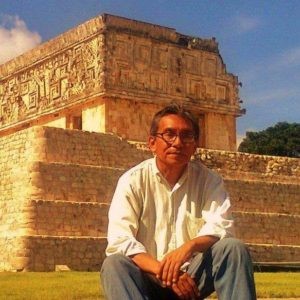In the mid-19th century, one of the most important writers and historians of the Yucatan Justo Sierra O’Reilly, said: “The Cathedral of Merida speaks to us in a language that perhaps the understanding does not understand,” a statement that is still valid today.
The Yucatecan Cathedral has its own architectural characteristics, which have been pointed out since the 20th century by various specialists. In 1929, the architect Federico Mariscal, pointed out that: “The facade of the Cathedral of Merida, impossible to be confused with others, has no resemblance to those of other regions of the country”.
The towers of this temple are an architectural element, of which some observations have also been made. Federico Mariscal indicated: “The towers, seen from the front and from its second body, are not in proportion to the first and appear off-centre”.
About this, the specialist Manuel Toussaint, emphasized that: “The towers, seen from the front, in the distance, seem cross-eyed, because their tops offer an inexplicable strabism”.
The Cathedral was built in a 36-year period, from 1562 to 1598, under the supervision of four bishops: three Franciscans and one Dominican. This Franciscan predominance in the constructive vigilance, is what could explain the aspect of strength that the Cathedral has, since the Franciscan architecture in America, during the colonial time, was characterized by having that appearance of fortification, one of the results of its apocalyptic theology, that aspired to build in the New World, the New Church of Christ, a spiritual construction with a material expression in its convents and churches, made in the likeness of the heavenly Jerusalem, described in the Apocalypse.
The colonial Mayans intervened in a decisive way in the building of the cathedral as laborers, it is known that 300 workers came from a community near Merida: Uman, as well as carpenters from Yucatan.
Beyond the physical participation in the construction of the Cathedral, the link of this temple with the Mayan existence can be observed in the indigenous colonial literature, and it is in this way that it is possible to read in the Mayan books of Chilam Balam, diverse references to the Cathedral.
In the Chilam Balam of Chumayel, some of the most important references to this Catholic temple can be found, in spite of the chronological errors, the quotes are related to the mythology and cosmogony of the pre-Hispanic Maya.
Some of them are: “In Ichcaansihó (Mérida) the foundations of the Holy Major Church were founded, the palace of God, the virtuous open house of God”. “Woe to the faces of the Great Figures when the owner of the House of Worship arrives in the middle of the city of Ho (Merida)” “In Trece Chen, Eb, the foundations of the Great Church were laid, the House of Learning in the Dark, the Great Church of Heaven. In the middle is the city of Hoó, the Main Church, the house of all, the house of good, the house of the night, which is of God the Father, God the Son, God the Holy Spirit”.
Thus, bearing in mind these brief historical, architectural, documentary and anthropological observations, we can begin a general observation of the Cathedral, as well as tours of its interior, courtyard and roofs, discovering in this Catholic temple, the trace of the Mayan symbols. A trip that we will start next week.
For The Yucatan Times, Indalecio Cardeña Vázquez
Merida, Yucatan February, 07 2020
 Indalecio Cardeña Vázquez. – Anthropologist, researcher and writer.
Indalecio Cardeña Vázquez. – Anthropologist, researcher and writer.
He has collaborated with the “Unidad Yucatán de la Dirección de Culturas Populares”, Instituto Nacional Indigenista and was the director of the Pinacoteca “Juan Gamboa Guzmán” of the INAH
Among his anthropological works are the iconographic analysis of the colonial sacred art of the Yucatan Peninsula; the symbolisms in the facade of Conquistador Montejo’s house, in Mérida; the Mayan symbolism in the Yucatan Cathedral and the archaeoastronomy among the Mayans.
Professor Cardeña has written several books and articles since the mid 1980’s to this date.



